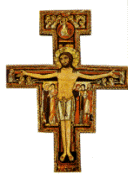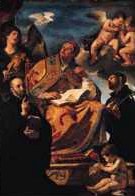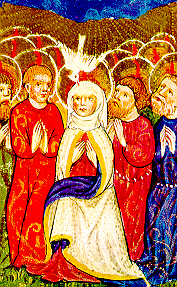 HISTORY
OF
HISTORY
OF
THE
CONFRATERNITY OF PENITENTS
Penance has a bad connotation in today's
society. People tend to think that penance means
self imposed punishment and gloom. How wrong
they are!
Penance means conversion, change for the better.
Change from doing things my way to doing them
God's way. That means that penance is a
joyful obligation! To do things the way
Someone far wiser than us wants them done can
only bring tremendous peace and joy.
The mortifications one employs to
help bring about conversion can involve
prayer, fasting and abstinence, works of mercy,
and simplicity of life, as they do in the Rule
for the Confraternity of Penitents. Those things
are only means to an end. The end is penance,
conversion to God. Conversion
isn't something that happens once and you've
arrived! Conversion, penance, is ongoing. Every
moment of every day, God calls each of us to a
greater surrender to Him, to a deeper "yes."
What is God calling you to, today?
Back in the 1100's and early 1200's, folks began
to look at themselves a bit more deeply. They
began to be upset that their world was so
materialistic, that injustice and war prevailed,
and that the poor were ignored. Heresy was
rampant, and it bothered these medieval
Catholics. What must be their response?
Their response was dictated by the Holy Spirit
Who called these people to deeper prayer and
sacrifice for the sake of their own souls and
those of others. A great penitential movement
spontaneously sprang up in Europe. No one person
began it. It simply happened all over, by the
prompting of the Holy Spirit, much as the
charismatic movement swept across the world in
the 1970's.
The people who embraced this life of conversion
were called "conversi" (converted ones) or
penitents. In contrast to the world around them,
the penitents greatly simplified and disciplined
their lives in the areas of prayer, fasting and
abstinence, and simplicity of life. They
embraced works of mercy and came together in
local gatherings to support each other in their
lives of conversion. They wore a distinctive but
simple garb to set themselves apart from their
more ostentatious neighbors.
Saint Francis and Saint Clare
Around July, 1206, a merchant in Assisi, Italy,
began to experience the first movements of
personal conversion. Francis Bernardone did not
struggle against the inner call that was
beckoning him into a deeper union with God, into
a new way of living. His response was, "Lord,
Who are You? And who am I?" and "What would You
have me do?"
Francis adopted the garb and life of a penitent
and, in time, as other converted men gathered
around him, he and his followers would tell
those who asked, "We are penitents from Assisi."
In time, Francis would write a Rule for his
little band; they would become known as the
Friars Minor and live at the Porziuncola, the
"Little Portion," a church on the plains of
Assisi, known formally as "Our Lady of the
Angels."
In 1212, a teenaged noble woman from Assisi,
Clare Offreduccio, sneaked out of her family's
palatial home and, with a servant, met Francis
and his friars who clothed her in penitential
garb and brought her to a convent to live as a
servant. Within a fairly short time, other women
had gathered about Clare, and the Order of Poor
Ladies had begun at the convent of San Damiano,
outside of Assisi.
Lay Followers
Francis and his begging friars and Dominic
Guzman and his preaching friars were sparking
massive conversions in southern Europe. People
also came to the Poor Ladies, who opened one
convent after another, for prayer. Seeing the
example of these holy religious, lay people
wanted to join them and many did. But many could
not enter religious life, as they had family
obligations which they could not dismiss.
So that these people could live lives of
conversion within their own homes, Francis
appealed to the protector of his friars,
Cardinal Hugolino di Conti di Segni, for a Rule
of Life. Cardinal Hugolino studied how the "conversi,"
the penitents, were living in southern Europe
and recorded their life style in a formal
document that became the Rule of 1221. Francis
gave this document to the laity. They embraced
it as brothers and sisters of penance.
The core of this Rule can easily be lost on
modern day penitents. Today's casual
reader can tend to focus on
the fasting, abstinence, prayer, apostolate, and
simplicity of life provisions of the Rule,
because they may seem "extreme" to modern minds.
However, those provisions were very
commonly followed by penitents all over Europe
at the time the Rule was written. The
guidelines for fasting and abstinence were
followed during penitential seasons by all
Christians. These mortifications in the
Rule were far from "extreme" in the 1200's.
What was "extreme" and what made the
Rule unique was its insistence on peace and
fellowship. Penitents who followed this Rule
were not to take up arms or swear allegiance to
anyone. They were to make peace with all and
meet together in supportive family-like
gatherings to learn of the things of God and to
commit themselves to charitable works. Because
so many medieval Catholics embraced the Rule of
1221, the feudal system in Europe began to
crumble. There were simply not enough men to
take up arms and fight for their medieval lords.
The lords had to devise peaceful means to settle
their disputes.
What Happened to the Rule of
1221
Penitents who wished to be closely connected
with the friars who followed St. Francis and his
successors adopted the Rule of 1221 as the Rule
for a lay Franciscan Order (Third Order as it
was third in order of founding). In 1289, Pope
Nicholas IV removed from the 1221 Rule many
local statutes that had been appended and placed
the penitents directly under the Friars Minor
who would serve as their Visitors. Other than
this change, the 1289 Rule was essentially the
same as the 1221 Rule.
In 1883, Pope Leo XIII radically modified and
relaxed the Rule of 1289 in the belief that
every Catholic would do well to become a
Franciscan. His making the Rule "easier" to live
did bring many laity into the Third Order of
Saint Francis. The Leonine Rule, as it was
called, was in effect for almost 100 years.
Vatican II, in the 1970's, asked each Order to
reexamine their Rules and return to the original
intent. Using the 1883 Rule as a base, the Third
Order of St. Francis rewrote the Rule as what is
now the current Rule of the Secular Franciscan
Order, also called the Pauline Rule of 1978
because it was accepted by Pope Paul VI.
Return to the Rule of 1221
The Confraternity of Penitents began in 1994
when one individual began, through an interior
call from the Holy Spirit and with the
permission of a spiritual director, to live
privately the Rule of 1221. Eventually the
idea of living the Rule of 1221 was shared with
others who, in 1995, founded
The Brothers and Sisters of Penance to assist them in living the Rule
together. On
the Queenship of Mary,
August 22,
2003, the Brothers and Sisters of Penance was
refounded as the Confraternity of Penitents
with a
Mass of Thanksgiving
held on the Eve of the Solemnity of Christ the
King.
The Confraternity
of Penitents
is a return to
the Rule of 1221 which has been updated, by its
Constitutions, for lay people to live in modern
society. Penitents may be
members of Third Orders or other Associations
within the Catholic Church, provided those
approve of their living this Rule. They are to
reconcile with all others to the full extent
that the others will allow.
They are to advance God's kingdom by
forgiveness, service, self-surrender, and love,
thus becoming images of Christ to a hurting
world. Many saints have come from the living of
this Rule of Life. May God make saints of those
who live it today!
What is a Confraternity?
In canon law, a confraternity is a voluntary
association, usually of laity, which is
established under
Church authority for the promotion of some work
of devotion, charity, or instruction undertaken
for the love of God. Confraternities are subject
to the assent of the bishop and their
Constitutions
subject to his approval.
Confraternities of Penitents were common during
the Middle Ages with over a hundred such
confraternities existing in Rome alone. Members
met together, often in their own churches, for
support and prayer. The confraternities were
distinguished from each other by a specific
garb, which concealed the identity of the
wearer, by their spiritual and corporal works of
mercy, and by different penitential and prayer
practices. Each confraternity took a name for
itself, often selecting the name of a saint, a
title of Our Lady or of Christ, or a specific
devotion of the Church. Many confraternities
were under the specific patronage of individuals
who later were recognized by the Church as
saints.
The modern Confraternity of Penitents is in a
direct line with those of the Middle Ages. Its
Rule is to be lived privately and quietly in
one's own home. The clothing colors and styles
are modern yet without being flashy or colorful
so that the general public is unable to identify
who is a member of the Confraternity. The Rule
has specific penitential and prayer practices.
Penitents participate in spiritual and corporal
works of mercy of their own choosing. The Rule
is intended to be lived in a supportive
community environment, whether in a local
gathering or through email or postal mail and
telephone support. The local groups take names
for themselves, selecting either the name of a
saint, a title of Our Lady or of Christ, or a
specific devotion of the Church.
MORE ON OUR HISTORY
A brief history of the Confraternity of
Penitents is part of our Constitutions.
Please view the Rule and Constitutions on this
link.
A more detailed recent history is on this
link.
The
Confraternity of Penitents has members in
various parts of the world. With the
ongoing guidance of our Visitor and Diocese, our members
embrace the life of conversion with joy, trusting in
God's guidance and desirous to live in peace and
love with all while gently witnessing to the
call to repentance preached by Our Lord Jesus Christ.
Any
Catholic who embraces all the teachings of the
Catholic Church as taught by the Pope and the
bishops in communion with Him is invited to
become a penitent and to live our holy way of
life in peace and joy. Please contact us
for more information.
May God bless all penitents everywhere! Please
pray for us.

Confraternity of Penitents
520 Oliphant Lane
Middletown RI USA
02842-4600
401/849-5421
bspenance@hotmail.com
copenitents@yahoo.com


